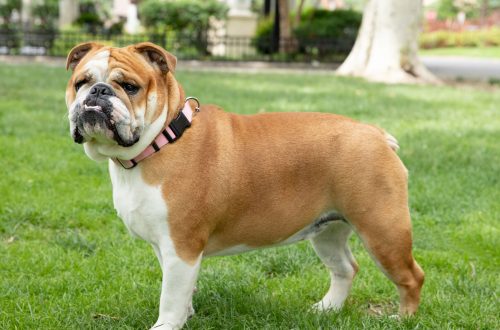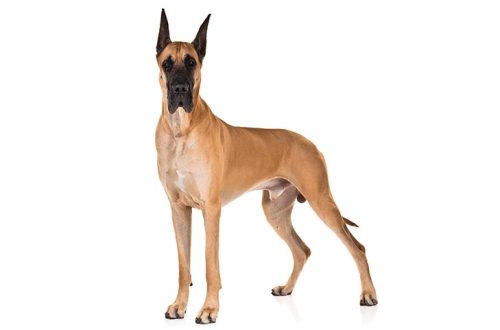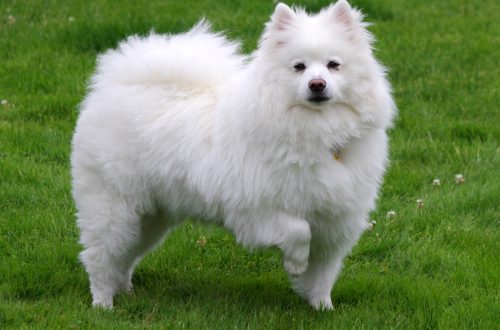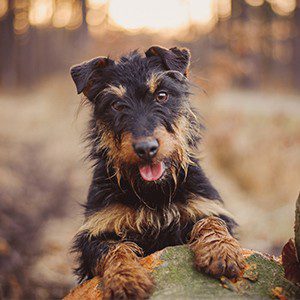
German Jagd Terrier
Other names: Jagd Terrier , German hunting terrier
The German Jagd Terrier is a close relative of the Fox Terrier and a versatile hunter, professionally working with burrowing animals, birds and other game species.
Contents
- Characteristics of German Jagd Terrier
- Basic moments
- History of the German Jagd Terrier breed
- Video: German Jagd Terrier
- German Jagd Terrier breed standard
- Photo of German Jagd Terrier
- Character of the German Jagd Terrier
- Education and training
- Hunting with a German Jagd Terrier
- Maintenance and care
- Health and disease of German Jagd Terriers
- How to choose a puppy
- Photos of German Jagd Terrier puppies
- Price of a German Jagd Terrier
Characteristics of German Jagd Terrier
| Country of origin | Germany |
| The size | average |
| Growth | 30–40 cm |
| Weight | 7.5–10 kg |
| Age | 12–15 years old |
| FCI breed group | terriers |
Basic moments
- From German, the name of the breed is translated as “hunting terrier”.
- The main qualification of Yagds is burrow hunting for fox, raccoon and badger, but with a competent coaching, the breed is able to work with a lined bird and even walk on a wild boar.
- The German Jagd Terrier has a high pain threshold, so in fights the dog is not able to adequately assess the situation and continues to fight, even after being seriously injured.
- The strong-willed and independent nature of the Jagd Terriers makes them not the most manageable pets that need a long walk, regular training and hunting trips.
- Despite the fact that the breed is successfully bred in Russia, among connoisseurs, representatives of the German and Austrian breeding lines are considered a more valuable acquisition.
- German Jagd Terriers can be involved in guard activities, but such work will not fully satisfy the hunting instincts of a pet.
- Because of their recklessness and excitement, German Jagd Terriers die on the hunt more often than representatives of other breeds. Innate insensitivity to pain is partly to blame for the “kamikaze effect”, as well as the overly active behavior of yagds in holes, contributing to the collapse of earthen tunnels.
- Due to the innate tendency to leadership, the breed is not recommended for owners who do not have experience with hunting dogs.
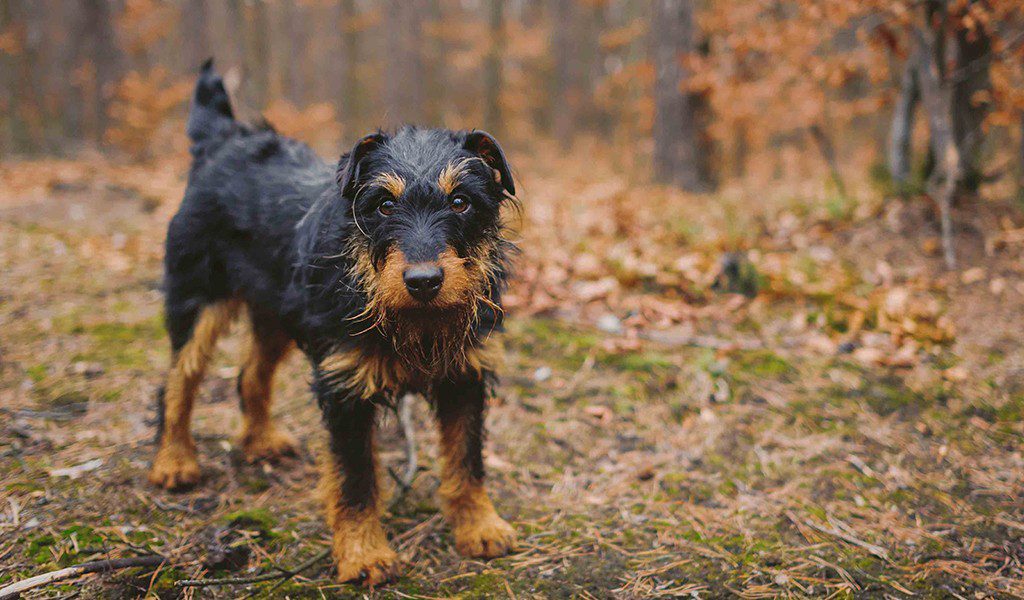
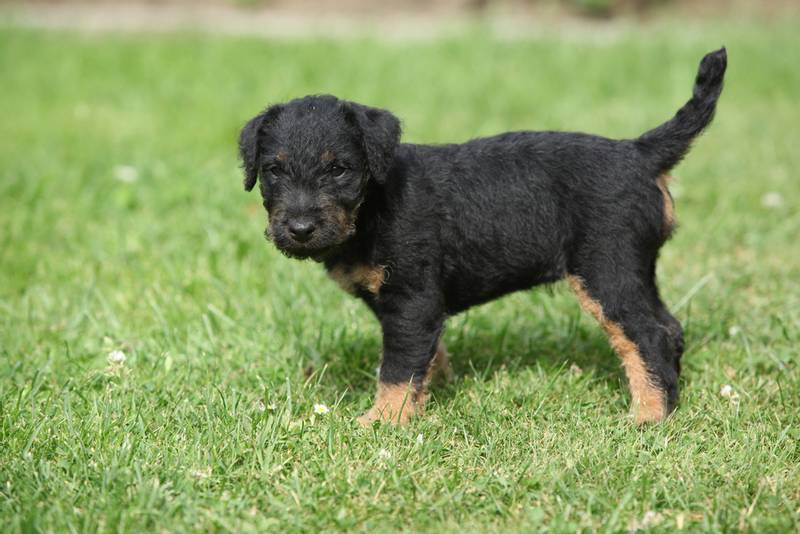
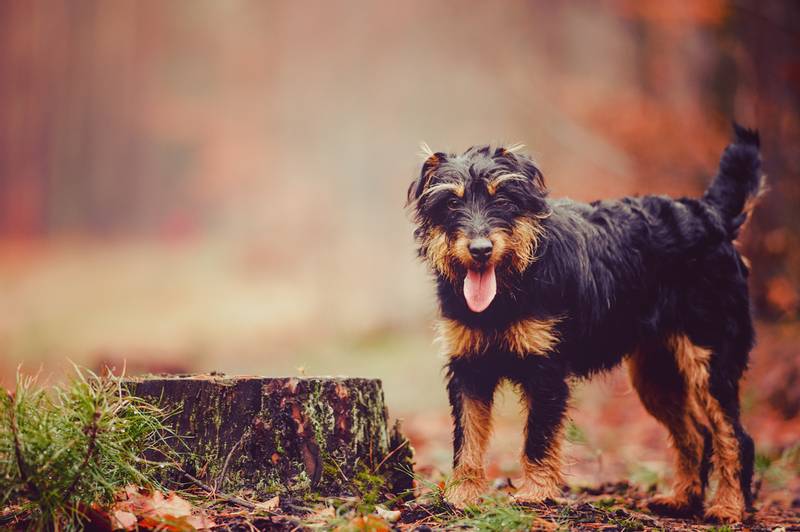
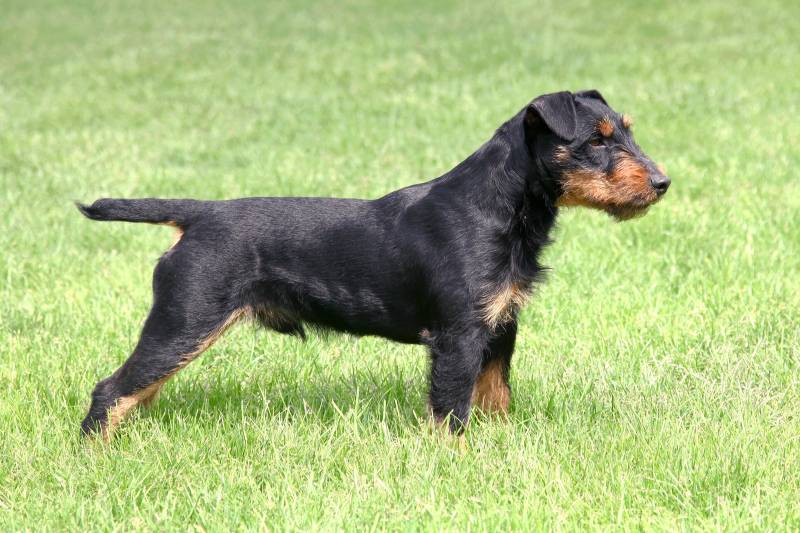
The German Jagd Terrier is the best friend for fans of burrow hunting and those who like to boast of fluffy feathered trophies. Passionate, tireless, persistent, this reactive pursuer is always focused on the result, which he often achieves at the cost of his life and health. It is realistic to control the behavior of the Jagdterrier if you can convince him of your own authority – the breed does not get sick of caresses and tenderness and appreciates only leadership qualities. On the other hand, yagdy are convinced monogamists. If the dog found you worthy of trust, then this is forever.
History of the German Jagd Terrier breed
The breed was formed at the beginning of the 20th century, when dog breeders, fed up with show terriers, began to dream of working pets that could bring real benefits. By that time, European exhibitions were filled with representatives of the group with an exemplary exterior, but absolutely unsuitable for working on the beast due to muffled instincts. After the First World War, German specialists began to develop a new, purely hunting variety of the terrier, ideally working in a hole.
The pioneer in this business was the dog breeder and part-time passionate admirer of fox terriers Walter Zangenberg, who was later joined by Rudolf Fries and Karl-Erich Grunewald. The breeder began his experiments by taking four fox terrier puppies from the director of the Munich zoo, Lutz Heck. Zangenberg was not embarrassed that the babies had a vicious black and tan color, since the breeder was going to develop hunting instincts in animals, and not glamorous appearance. As a result, the matured puppies were mated with black foxes, known for their phenomenal viciousness and tirelessness in pursuing the victim.
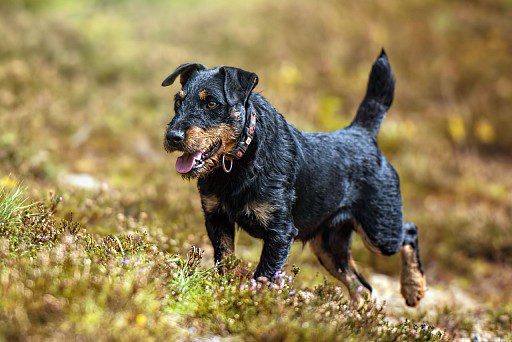
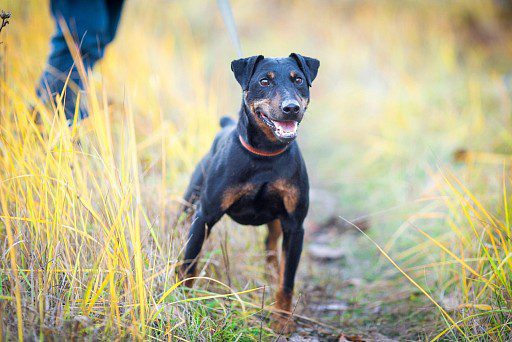
In 1926, the first Jagdterrier club opened in Germany, and 12 months later, Zangenberg’s wards began to be exhibited at the exhibition. At first, the breed was bred by inbreeding (inbreeding), which did not have the best effect on the health of the offspring. And only in the 1920s, dog breeders began to involve more distant relatives – Welsh Terriers and Old English Terriers – in pumping yagds. After the Second World War, the breeding of the breed was no longer so active, which was facilitated by the division of Germany into occupation zones. In addition, the breeders of the GDR relied on the selection research of Zangenberg, that is, they continued to cross relatives of Yagds among themselves. As a result, the number of dogs quickly recovered, but the number of defective individuals began to grow exponentially.
International recognition came to Jagd Terriers in 1954, along with the FCI standard. After this event, dogs began to be exported to North and South America, but the small and nimble berries did not make the proper impression on New World hunters. German terriers were brought to the USSR in the 70s, although unofficial sources claim that the first acquaintance of domestic breeders with the breed took place 40 years earlier. Of the manufacturers imported to the Soviet Union, Cherry von Richebach, Dina von Gochlitsee, and Enke von Wolzi-Gersee are especially worth noting. It was these individuals that laid the foundation for the first generations of Russian Jagd Terriers.
Video: German Jagd Terrier
German Jagd Terrier breed standard
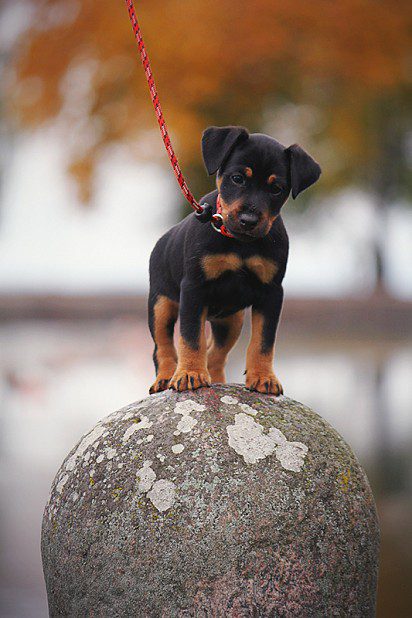

Like a real hard worker, not accustomed to lying on the couch and posing in front of the camera, the Jagd Terrier can not boast of either a stylish satin “fur coat” or a special touching appearance. However, he does not need this, since the vast majority of breed owners are practical people who demand professional skills and an exciting hunting show from their pet, but are absolutely indifferent to the exterior of the ward. Accordingly, the correct German Jagd Terrier is first a hardy and strong earner, and only then a friend, companion and everything else.
The standard height of the yagda ranges from 33-40 cm, and these figures apply equally to both females and males. But the weight categories for dogs of different sexes are different. Female yagdy girls weigh between 7.5 and 8.5 kg, while males are able to build more voluminous muscle mass, keeping the weight in the range of 9 to 10 kg.
Head
The head of the German Jagd Terrier looks moderately elongated with distinct cheekbones and a developed chin. The skull is of a flattened type, rather spacious in the area between the ears. The muzzle is shorter than the head, not strongly pointed, with a light stop.
Jaws, lips, teeth
Representatives of the breed have massive, closed jaws in a complete scissor bite, hidden by brightly pigmented dense lips. The teeth are large, set evenly, in the amount of 42 pcs.
Nose
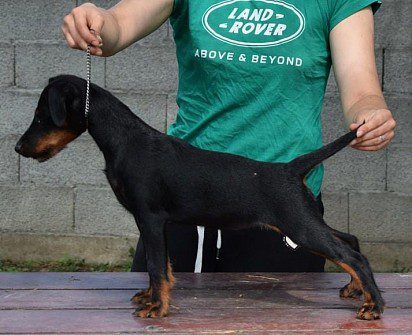

The dogs have a harmoniously developed, small nose, mostly black in color. A brown shade is acceptable for individuals with the same coat tone.
Eyes
The German Jagd Terrier is a dog with a determined, direct look. The eyes of the animal are small, oval, located at a distance from each other, which minimizes the risk of damage from the paws of forest predators.
Ears
The ear flap of a purebred yagde is set high, has medium size and a regular triangular shape.
Neck
According to the FCI standard, animals must have strong necks of normal length, gradually turning into shoulders.
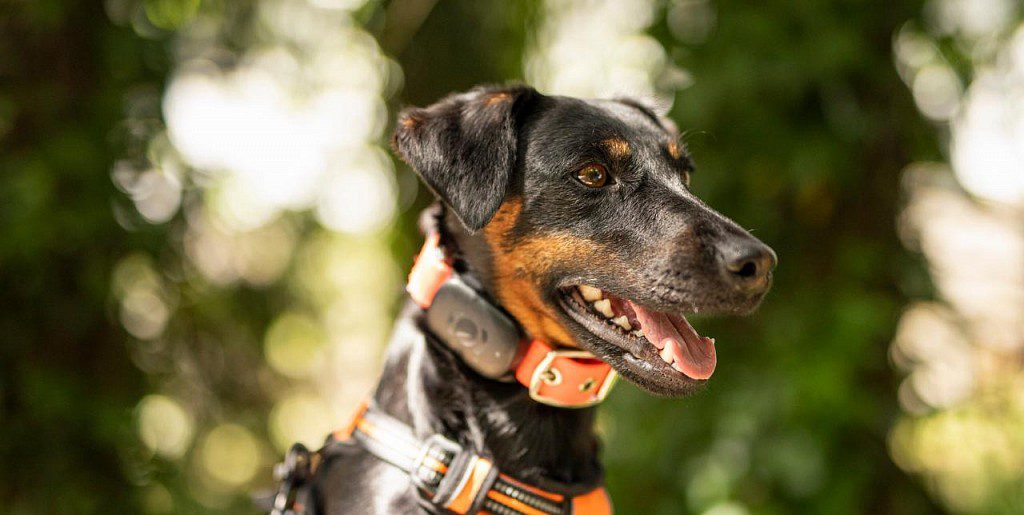

Body
The German Jagd Terrier is a compact breed. Mandatory condition: the girth of the dog’s sternum must be 10-12 cm more than its height at the withers. The length of the body also exceeds the height at the withers, but only slightly. The top of the body is straight, with a muscular loin and an impressive horizontal croup. The chest of the animal should be deep, with ribs arched back. The line of a slightly tucked-up belly, which has a graceful bend, looks very elegant.
limbs


A prerequisite for the legs of the German Jagd Terrier is their parallelism to each other when viewed from the front and back. In addition, the limbs must have strong bones and dried muscles. The shoulder blades are of an elongated type, oblique, with developed muscles. Elbows are located close to the body without a clear eversion to either side. Forearms steep, straight.
The hind legs of the dog look more solid due to elongated, moderately wide hips. Elongated sinewy shins, short sheer metatarsus and strong hocks are responsible for springy propulsion in movement. The rounded oval paws of the yagda are “reinforced” with hard, intensely pigmented pads, and the front paws are noticeably larger than the hind ones. In the stance and gait, the feet must not turn inward (clubfoot) or outward.
Tail
Jagdterriers living in countries where docking is prohibited have long tails of a straight or saber-shaped design. Such a tail is carried horizontally or slightly raised at the top. Working dogs in Russia have their tail docked by ⅓. In this case, he takes a slightly elevated, but not vertical position. In addition, the tip of the last vertebra should not deviate towards the back, since in conditions of burrow hunting the tail plays the role of a “handle” by which the owner can pull an angry dog out of an underground tunnel.
Wool
German Jagd Terriers come in two varieties: wire-haired and smooth-haired. In both cases, the guard hair has a coarse, dense structure that helps the dog not get wet in rainy weather and protects the body from mechanical damage during hunting.
Color
Today’s German Jagd Terrier is a brown, black or greyish-black dog with tan markings on the sternum, legs, muzzle, under the tail and on the eyebrows. Permissible features: the presence of dark and lightened masks on the muzzle, the presence of tiny white spots on the toes and chest.
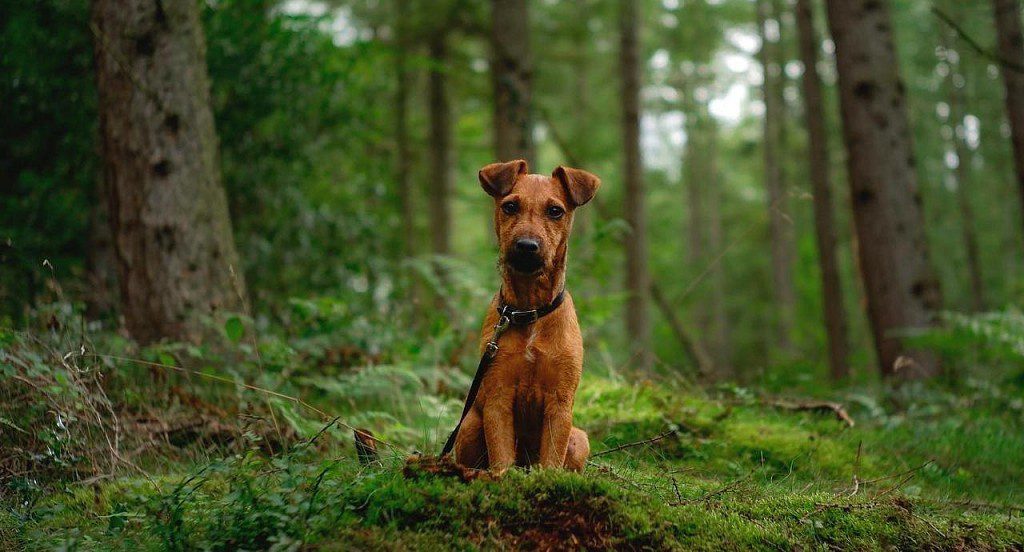

Faults and disqualifying vices
External features that do not fit into the parameters specified by the standard are positioned as exterior defects. There can be many such shortcomings, ranging from an overly pointed muzzle to loose toes. If an animal has malformations of behavior and development that overlap its pedigree qualities, this is almost always a disqualification at the exhibition. The most common disqualifying vices of yagd terriers:
- disagreement, iris of a blue tint or with speckles;
- malocclusion, including misaligned jaws and misaligned incisors;
- incomplete dental formula (lack of M3 does not count);
- inversion or eversion of the eyelid;
- non-standard pigmentation of the earlobe, lips, paw pads;
- too high or low growth;
- weak character, fear of shots and wild animals.
Photo of German Jagd Terrier
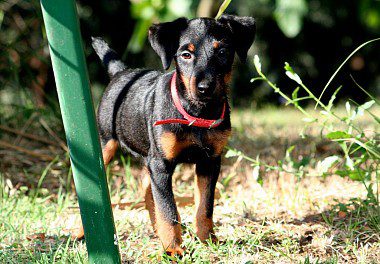

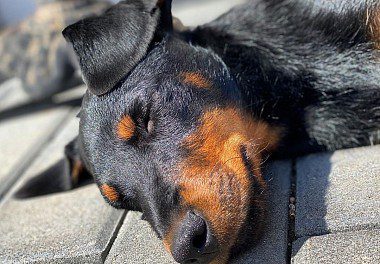

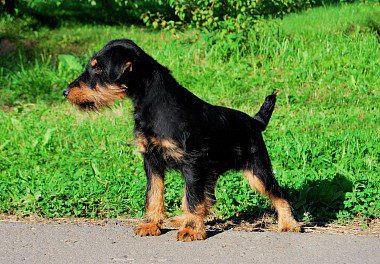

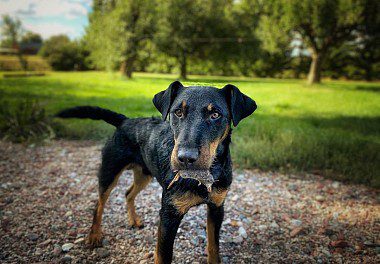

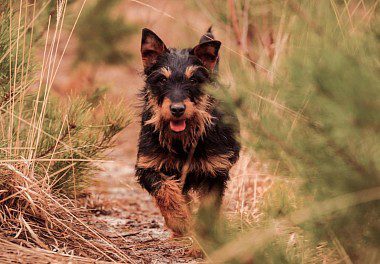

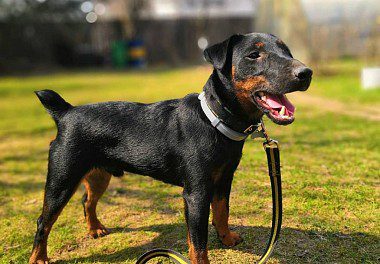

Character of the German Jagd Terrier
It is important to understand that the German Jagd Terrier does not exist outside the hunt, so buying a dog for yourself, children or “on the sofa” and expecting aristocratic manners from it is not the most logical act. However, even a jagd who regularly travels to the forest and works on the beast is still a shrew. So say goodbye to the dream of fashioning an obedient “deliverer” of slippers out of a pet – this breed likes to cooperate, but not to serve and fawn.
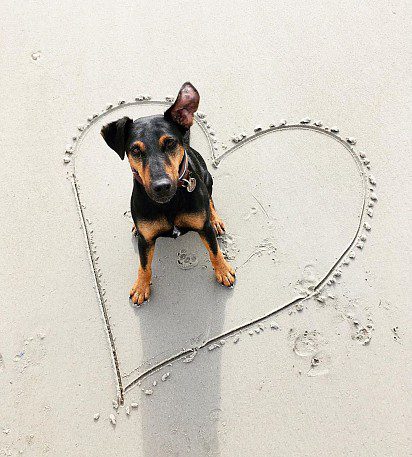

It is believed that professional training and early education can muffle the aggression and stubbornness of German Jagd Terriers, but there are some nuances here. Yes, a dog can be weaned from the habit of attacking strangers, but even an experienced cynologist will not be able to make him fall in love with a cat or other domestic furry. Berries also attack small wild animals. For example, in rural areas, hedgehogs become one of the main victims of the breed. Black and tan “gladiators” are not stopped by needles or the injuries they inflict – reprisals against a prickly enemy are committed immediately and to the bitter end.
With unfamiliar dogs the same story. German Jagd Terriers have a strategic reserve of courage and the same amount of recklessness, therefore they are able to provoke conflict with their fellow tribesmen for no reason. The breed also has no time to understand the hierarchical system of the canine world, so even puppies of yagds easily go to extremes like encroaching on someone else’s bone or violent attacks on an adult wolfhound. Moreover, the larger the opponent, the more chances he has to piss off the terrier – the impressive dimensions of the opponent cause the “Germans” a mixture of black envy and hatred.
In relations with a person, a yagd prefers not to be scattered, but to concentrate on one person. Usually this is the one with whom the animal goes to feed and hunt. The dog recognizes the rest of the family members insofar as it is in no hurry to fulfill their requirements. The companion qualities of the breed are also tied to working instincts. The yagd terrier will obediently behave on a walk only in a situation if there is one nearby, under whose leadership the animal is used to getting game. With all the rest of the household, “feedback” will be episodic, so you can let the ward off the leash in the park in one single case – if this park belongs specifically to you and there is not a single representative of the wild fauna in it.
Education and training
The German Jagd Terrier is a breed that needs to be brought up “yesterday ago”. It is recommended to use traditional methods, but with an eye on the tendency of yagds to dominate, expressed in biting family members, suppressing other animals, attacking random passers-by. So in the process of education, do not forget to inspire the dog with respect for yourself and the household, showing her that the boss’s chair has long been firmly occupied.
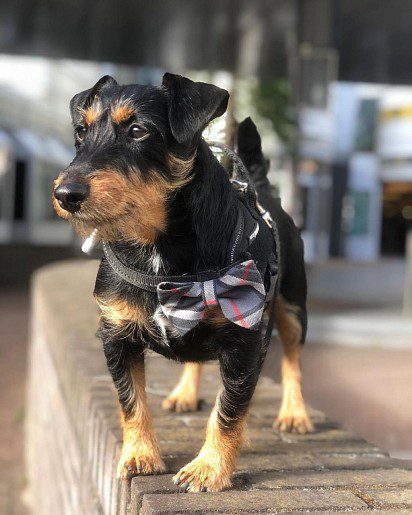

In intellectual terms, the Yagdy may not be geniuses, but quite smart comrades, so they have no difficulty remembering commands. At the same time, the ideal adherence to the “charter” is not their forte. As an example: it is realistic to train a German Jagd Terrier OKD in six months, but it is pointless to demand from him the endurance and diligence of a German Shepherd. Moreover, pet mistakes should be treated with indulgence: in the end, you chose the perfect hunter, and not a circus performer and watchman. Connivance, however, is also not worth it. Basic OKD commands will later come in handy on the hunt, because with their help it will be possible to control the behavior of the dog.
The critical age for representatives of the breed is 6 months. It is during this period that the German Jagd Terrier begins to test the owner’s patience for strength with redoubled energy. The training of raging teenagers should not be canceled, but with a lack of personal experience, it is better to involve a professional in the matter. An obligatory part of the program in the upbringing and training of the Jagd Terrier is accustoming to the collar, leash and muzzle. The breed does not favor the last accessory, but without it it is dangerous to let the four-legged varmint out into the street if you do not want to later save homeless cats and conflict with passers-by, shocked by the attacks of the yagda.
Approach the process of putting on the muzzle carefully, without haste. Experts recommend first giving the dog a sniff of the device, as well as putting your pet’s favorite treat inside the net. It also takes time to get used to the muzzle. In the first days, 2-3 minutes of wearing the limiter will suffice, then the duration of use can be increased to half an hour or more.
Hunting with a German Jagd Terrier
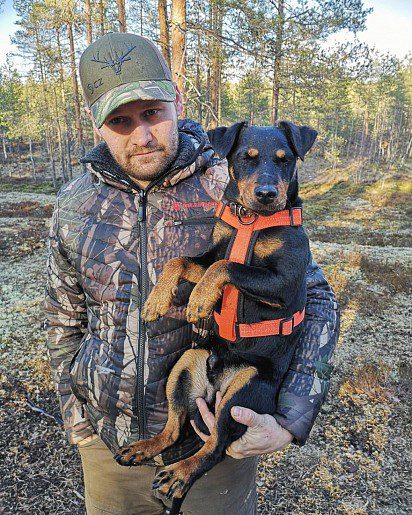

The breed is universal and works excellently underground, on land, in water, but all this is subject to high-quality training and grafting. It is believed that individuals from the Soviet lines were angrier to the beast than their current descendants, but in general, the berries retained the purity of their hunting instincts and phenomenal viscosity. The German Jagd Terrier is an excellent fetcher of small game, especially waterfowl. Representatives of the family are ready to dive for a lined feathered bird in a reservoir of any depth, without suffering at all from low temperatures. For example, there are cases when animals fished out a trophy even during ice drift.
If desired, the dog can be involved in gun hunting to search for wounded animals, as well as to bait a wild boar. True, in the second case, a support group consisting of representatives of hound breeds will be required. But the real element of the German Jagd Terrier was and remains burrows. Moreover, it is not recommended to bring the pet to a direct fight in the hole. The task of the yagd is to keep the predator until the hunter arrives. If the dog is too dispersed and tries to deal with the fox or badger on its own, it must be removed from the underground labyrinth by the tail.
The first inoculation should be carried out no earlier than the animal is 8-10 months old. For this purpose, a “running” fox is used, keeping a decent distance and not rebuffing the pursuer. Remember that a puppy at this age has an unstable psyche, and aggressive game can discourage him from hunting for life. You can build a hole for training yourself, or you can use ready-made designs of baiting stations. The main thing is not to put pressure on the dog and not push it into the maze. The Jagd Terrier should become interested in the hole and dive into it.
The first to practice the skills of searching and chasing the beast. The second stage is the training of anger and grip, and the last skill is recommended to be “put” on a raccoon. Unlike the fox and badger, this minke whale is not capable of causing serious injury to the pet. Some hunters bait berries on stray cats, but this method is discouraged as it trains the dog to view pets as potential game. By the way, among professionals, yagd terriers are especially valued, which do not torment the beast to shreds, but competently dodge its claws.
Maintenance and care
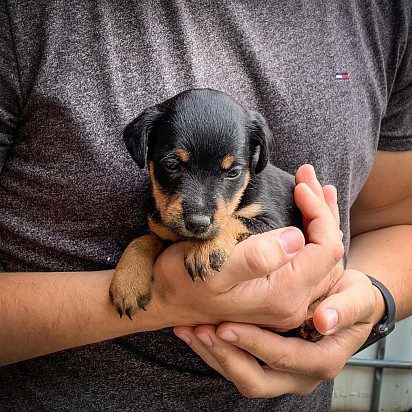

The German Jagd Terrier is an inquisitive choleric and hard worker who needs constant fresh impressions, so the breed is recommended to be kept outside the home walls. On the other hand, the climate of the middle lane is cold for yagds, so the arrangement of a spacious aviary and an insulated booth with a floor is considered a necessary measure. Putting a dog on a chain is strictly prohibited – such movement limiters break the psyche of the animal, making it uncontrollable and aggressive. If the pet is too vicious towards guests who have stepped into the yard, it can be temporarily isolated in an aviary.
Keeping a hunting terrier in an apartment is less preferable, but possible. In this case, the pet will have to compensate for the lack of impressions with frequent and long walks – from 3 hours a day or more. If the dog lives in a country cottage with a plot of land and a garden, you can take him outside less often. Let your four-legged friend run around the yard, make a couple of digs in places where there are no beds and flower beds – this will help the yagdu quench his thirst for activity and make him less insistent on excursions outside the house.
Hygiene
The German Jagd Terrier is not a decorative fluffy, he does not need visits to the groomer. To make a smooth-haired hunter look neat, it is enough to comb it with a brush or rubber mitt, massaging the skin and thus removing dead hairs. During the period of seasonal molting, the frequency of combing will have to be increased, but even if this is not done, the yagd terrier will not fill up the apartment with woolen “stacks”.
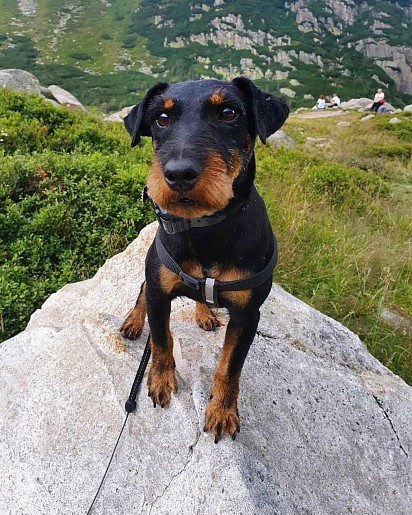

With wire-haired individuals, you will have to tinker a little longer. By the way, despite the fact that formally trimming and shearing the breed are prohibited, most owners pinch their shaggy wards. There is no serious crime in such hygiene procedures, but only if the dog starts up for work. Owners who plan to travel with their “Germans” to exhibitions will have to forget about trimming forever, or do it a few months before the event so that the coat has time to grow and even out.
Otherwise, the care of the German Jagd Terrier is the same as for any dog. Check your pet’s eyes daily for inflammation and dust, and also wipe them with strong tea infusion or chilled chamomile decoction. Do not forget to inspect the ears, especially if you hunted with a yagd the day before – there may be garbage and ticks inside the funnel. Be sure to have in your home first aid kit remedies for ectoparasites that terriers acquire while hunting. And of course, keep your paws healthy. After walking and hunting, check for cuts and peeling on the pads, and periodically lubricate the skin with unrefined vegetable oil and greasy hand cream.
It is desirable to wash German Jagd Terriers as little as possible. First, hard tap water and pet shampoos degrade the quality of wool. And secondly, the yagd already bathes enough on the hunt, jumping after a lined bird into a pond. An exception can be made when an unpleasant amber comes from a dog. Hunting terriers love to wallow in carrion, and even in excrement, which they use as a camouflage against their own smell. So if the pet “smells” too intensely, he is supposed to have a bath day. In summer, the Jagd Terrier is allowed to be taken to a deserted beach, where he swims with pleasure and plays enough.
Feeding
An actively hunting Jagd Terrier eats everything that is offered to him with appetite. Mandatory products in the dog’s diet are sinewy meat and its trimmings, offal, cereals (buckwheat, rice, millet, oatmeal), fish fillet, low-fat cottage cheese and kefir. The menu of puppies includes natural milk and eggs, but adults can easily do without such “frills”. The best dish for a hunting dog is porridge or soup on meat and bone broth, to which, in addition to cereals, potatoes, offal, beets, carrots, and cabbage are added. So that the pet is not tempted to choose more delicious pieces, it is better to wipe the soup until smooth. In the spring, it is useful to add chopped young greens and nettles scalded with boiling water to the feed.
The need for fats in animal dogs is an order of magnitude higher than in pets, so experts recommend mixing baked beef and fish oil into the food. Rye bread is given only in dried form and only as a treat. If you don’t like brushing your German Jagd Terrier’s teeth, treat your dog with cartilage and sometimes flat cancellous bones more often. This is both a source of collagen and at the same time a “brush” that removes food plaque. Vitamin complexes from the zoo pharmacy will also not be superfluous, but it is better to select them after a veterinary examination.
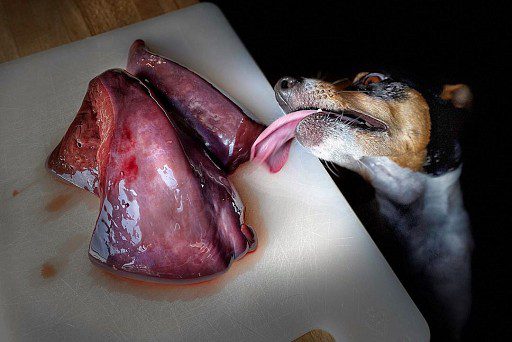

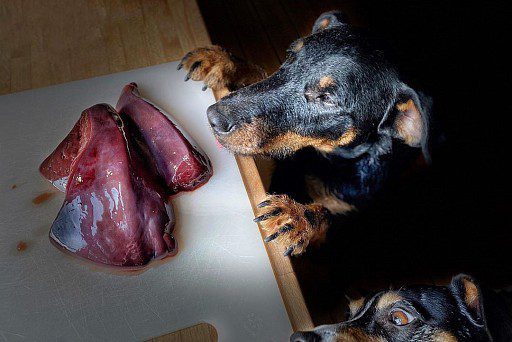

Owners who want to save their own time and effort transfer berries to dry food. This is acceptable, but in order for industrial food to bring benefits and completely replace a balanced natural diet, it is necessary to choose varieties of the premium and holistic segment. As for the frequency of feeding, the adult Jagd Terrier should eat twice a day; a puppy under the age of 2.5 months – five times; baby from 2.5 to 4 months – four times; teenager from 4 to 8 months – three times a day.
Health and disease of German Jagd Terriers
Like most working breeds, German berries do not suffer from excessive morbidity and do not inherit dozens of genetic ailments from their parents that interfere with an active life. An exception to the general rule is the displacement of the lens, which is inherent in all representatives of the terrier group, and the Ehlers-Danlos syndrome. The latter disease is also found in other breeds and is expressed in excessive elasticity and flabbiness of the skin.
To this day, there is no cure for Ehlers-Danlos syndrome, so the only thing that can be done for an animal with such lesions of the dermis is to minimize the risk of injury and tissue ruptures, which then have to be sewn up by a veterinarian. German Jagd Terriers are not immune from infectious and viral diseases, so do not neglect vaccinations against distemper, rabies and piroplasmosis. This is especially true for dogs that regularly hunt and risk catching the disease from wild animals and ticks.
How to choose a puppy
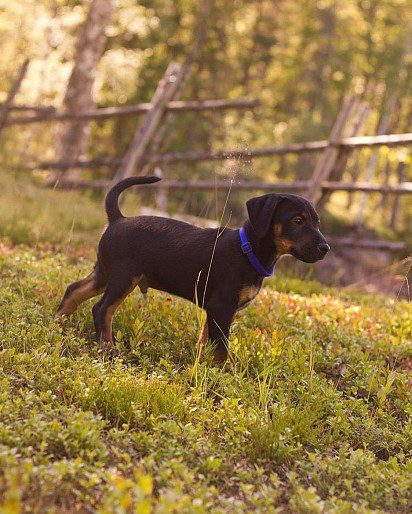

- For frequent hunting trips, German Jagd Terrier males are preferable. Females in work with the beast are often hindered by estrus, during which concentration and endurance decrease.
- Observe how the animal behaves with littermates. Little berries often put up fights in which there are winners and losers. If during the conflict the puppy turned out to be an outsider and retreated at the beginning of the battle, this indicates his cowardice and failure as a future hunter.
- Hunting experience and working diplomas of the parents of puppies are an important attribute. Good viciousness and toughness are inherited by German Jagd Terriers.
- Check the accuracy of the information given by the seller about the litter and producers. Contact the Jagdterrier breed club and find out whether the mating was really planned and whether the puppies born after it claim to be pedigrees.
- Do not choose the most cocky and aggressive kid. Having matured, such an animal will have an explosive character, which will complicate the process of education and training.
- The right German Jagd Terrier puppy will not be intimidated by the presence of a stranger in the kennel, but will resist attempts to roll him over on his back. Such a reaction is considered normal and adequate, unless the baby chokes on a screech and growls.
Photos of German Jagd Terrier puppies
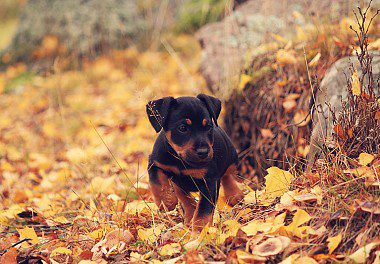

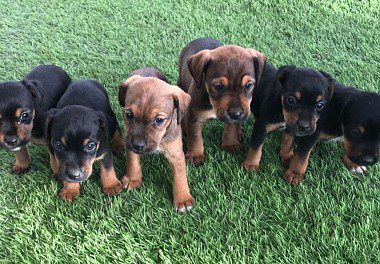



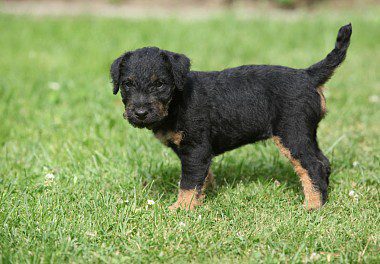

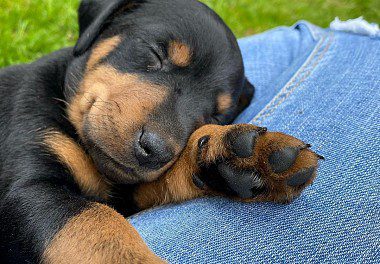

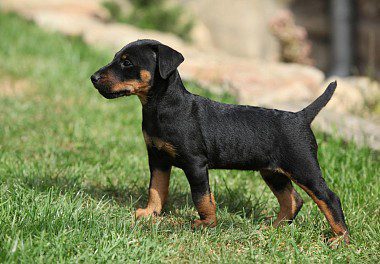

Price of a German Jagd Terrier
Club puppies of a German Jagd Terrier from parents with working diplomas and a package of documents will cost 250 – 350$. If passing field tests and going to exhibitions are not planned, you can turn to familiar hunters who periodically knit their wards. Such berries are much cheaper, in the region of 200-300$, but in terms of working qualities they are not inferior to offspring from champion producers. The only caveat: puppies from a non-professional breeder may not have puppy metrics, which casts doubt on the purity of the litter.





